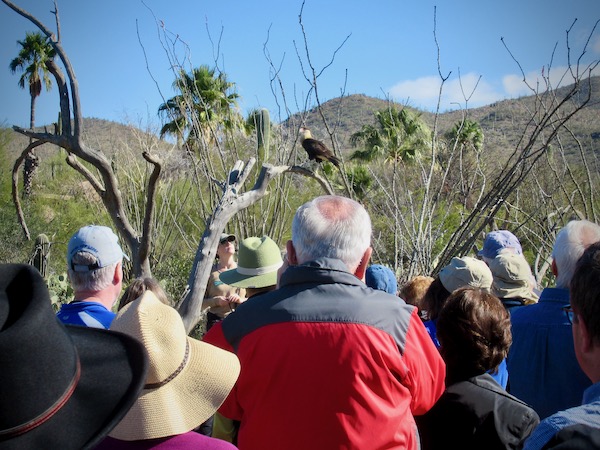
The birds of prey handler keeps warning me to lower my arm, which like so many others has a phone or camera attached to it. I’m sorry, but I can’t take a very good photo from my waist. He says the red-tailed hawk can see a raised glove (or phone or camera) at 3,000 feet, and it can strike at speeds of more than 70 mph. I lower my arm.
I am at the “Raptor Free Fight!” exhibition at the Arizona-Sonora Desert Museum, just west of Tucson. Other than being repeatedly shooshed, this is like no museum I’ve ever visited. The Sonoran desert comes alive here – a living, breathing ecosystem. The amazing birds of prey show takes place at 10 am and 2 pm daily from October 29 to February 29.
The birds are wild and free, but come in (if they feel up to it) for treats. For 45 minutes, I watched them swoop and soar, land and take off – and sometimes fly a mere inch or two over my head. The stars of today’s unscripted performance include a Chihuahuan raven, great horned owl, red-tailed hawk and northern crested caracara. Only the ferruginous hawk failed to show, opting for a live desert kill today.
After the amazing show, an outdoor stroll takes me past a coyote, bighorn sheep and “Don’t call me a pig!” javelina. Among other differences, the javelina does not have a gall bladder and has only one or two babies at a time, while a pig can have up to 20.
At 12:15 pm, inside the auditorium, another show begins. The first performer today is the tiger rattlesnake, a highly poisonous pit viper. This rattlesnake kills with the help of holes under its eyes. The pits act as heat sensors, and can detect temperature variations as small as 1/3000th of a degree.
The other start attraction is the Gila monster, the only venomous lizard native to the United States. Fierce looking but slow moving, the Gila monster was completely mischaracterized in 1959’s “The Giant Gila Monster,” where a Hollywood-sized version of the lizard terrorizes a small, rural community in the Lone Star State. While the Gila monster can eat up to one-third its body mass in one feeding, it can not possibly eat an entire Texas town!
My key takeaway today is this: If you get bitten by a rattlesnake, there generally is not much you can do but go to the nearest source of anti-venom. The cut and suck method heralded in old Westerns is another Hollywood fail. Ideally, experts say, you are supposed to sit still and remain calm, keeping the wound (if possible) below heart level while you wait for the ambulance. Yeah, right. I’m totally calm … on my hike in the middle of the 5G/LTE- and ambulance-laden desert … after just being bitten by a toxic viper.
I’m completely sold: The desert is out to kill me. Enjoy the show.
NOTE: Entry to the Arizona-Sonora Desert Museum costs $24.95 for adults 13+ and $11.95 youth ages 3-12 during the high season. Open daily, 8:30 am to 5 pm. (October through February); 7:30 am to 5 pm (March through September).














